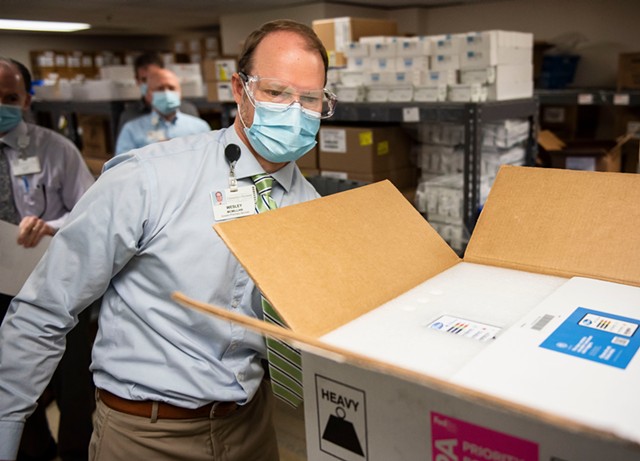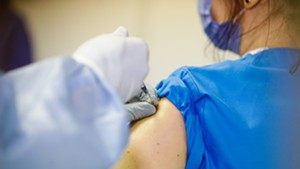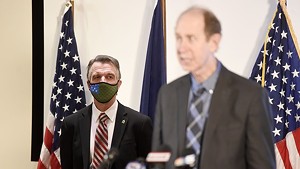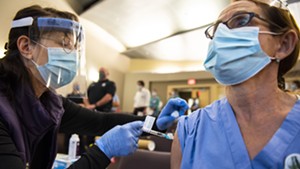
- Courtesy of the University of Vermont Medical Center
- Wesley McMillian, director of pharmacy at UVM Medical Center, with a shipment of vaccine
Vermont will use drive-through vaccination clinics, a media campaign and cooperative efforts with New Hampshire in order to get residents inoculated this spring.
The state is now shifting much of its focus to younger Vermonters. Everyone 16 and older will be able to sign up for vaccination appointments by April 19, with smaller "age bands" eligible in the preceding weeks.
“Hopefully those age groups will see a variety of messaging campaigns on social media and traditional media,” Health Commissioner Mark Levine said on Tuesday at one of the state’s twice-weekly COVID-19 briefings.
Levine said state officials will employ a persuasive, not dictatorial, tone with young people, many of whom might not think COVID-19 could have much impact on them. He said symptoms such as chronic fatigue, brain fog, memory loss and shortness of breath can occur weeks and months after infection with the virus, even in the young.
“I don’t wish that on anybody,” Levine said of such symptoms. “These can creep up on them over months and be debilitating.”
Also part of the strategy: trying to get young people to promote the shots to their friends.
“Us telling them what to do is not going to work,” Human Services Secretary Mike Smith said. “I think you’ll see a strategy that relies on peers talking to peers.”
The vaccination campaign for older Vermonters is still in full swing. Those age 60 and over can begin registering for their vaccines on Thursday. By Friday, Smith said, one in five people in the state will have had both shots. And on Monday, March 29, those 50 and over can begin signing up for their shots.
The state’s goal is to have everyone who is willing to accept a shot vaccinated by July 1. Vermont is administering between 3,700 and 7,900 doses per day, seven days a week, for an average of 5,500 daily shots, Smith said.
But while hospitalizations and deaths have diminished as more vulnerable Vermonters are vaccinated, case numbers are stable or rising in Vermont and in other states in the Northeast. Levine said it’s not yet clear why, but he noted the growth of the virus is cyclical. Last year, case numbers soared in the Northeast before dropping, and then rising and falling in the South and West. The virus surged in the Midwest in the fall before dropping there.
“If you give it enough time without a vaccine yet, and a population that is not immune, it repeats the cycle,” Levine said.
The state reported 850 new cases over the last week, an increase of 61 cases over the total the week before, Finance Commissioner Mike Pieciak said. The Northeast saw 8,000 more cases this week than last week.
The state has had an average of 100 to 120 new cases each day, a number only about 25 percent lower than that of Vermont’s peak in January. But hospitalizations are down 62 percent from the peak, and the state has the second-lowest per capita fatality rate in the country, Pieciak said.
With warm weather on its way, case numbers are expected to follow those in most other parts of the country and start declining, Pieciak said.
“I don’t think there is any one theory to explain it,” he said of the relatively high numbers now.
State and local officials met last Thursday in the Northeast Kingdom to talk about ways of raising vaccination levels there. They discussed putting up road signs to advertise existing vaccine clinics, adding more clinics, and partnering with health providers on the other side of the Connecticut River in New Hampshire, where many northeastern Vermonters go for their primary care, Smith said.
Vaccines that are being tested now mean shots could become available for high school students as early as next autumn, and for younger children at the beginning of next year. As for the willingness of the young to fall in line with the state’s vaccination goals, Levine sounded upbeat.
“Sometimes it’s not a very profound reason why someone isn’t getting vaccinated, like, ‘It doesn’t fit in my schedule,’” he said. “As we start thinking about our high school students, college students, there are certainly opportunities to bring vaccines to them.”

















Comments
Comments are closed.
From 2014-2020, Seven Days allowed readers to comment on all stories posted on our website. While we've appreciated the suggestions and insights, right now Seven Days is prioritizing our core mission — producing high-quality, responsible local journalism — over moderating online debates between readers.
To criticize, correct or praise our reporting, please send us a letter to the editor or send us a tip. We’ll check it out and report the results.
Online comments may return when we have better tech tools for managing them. Thanks for reading.